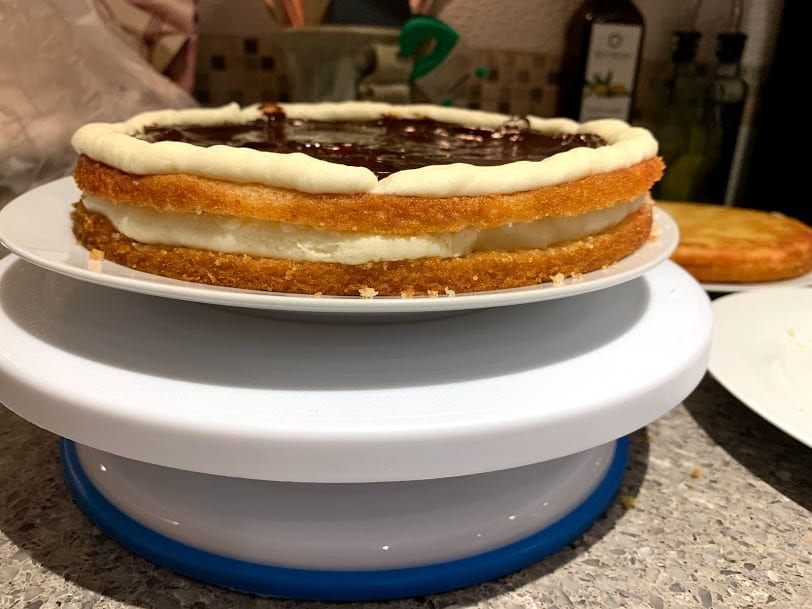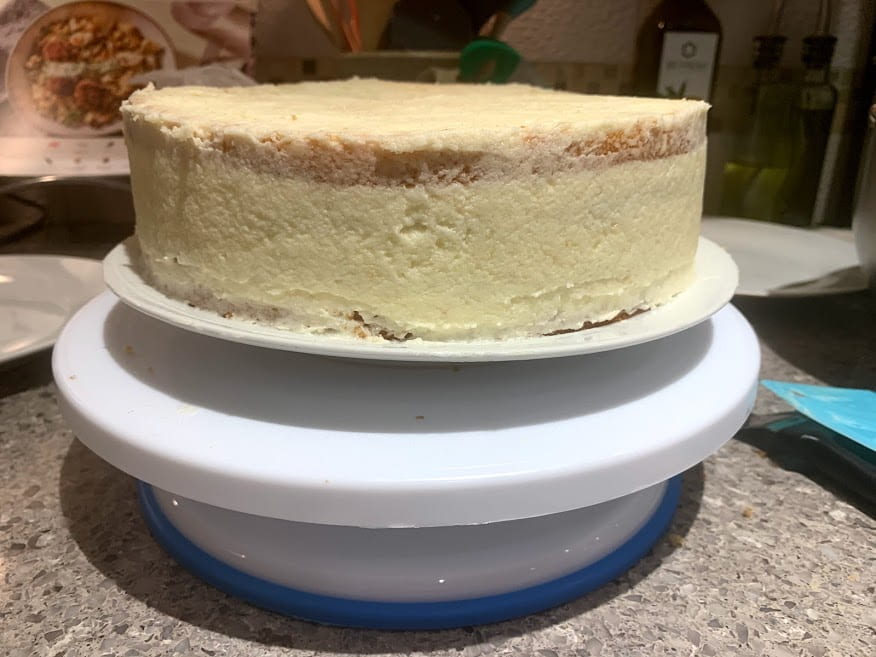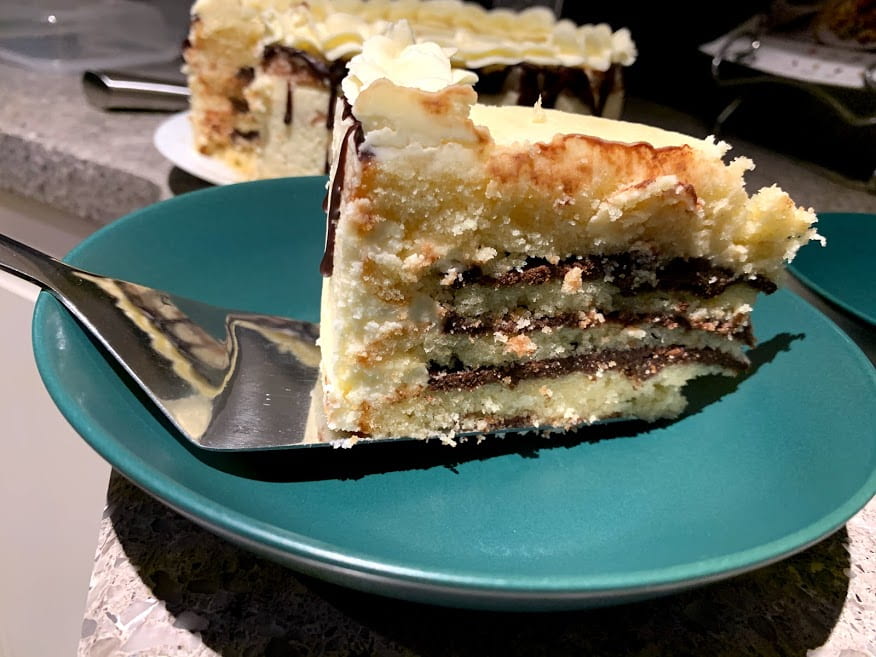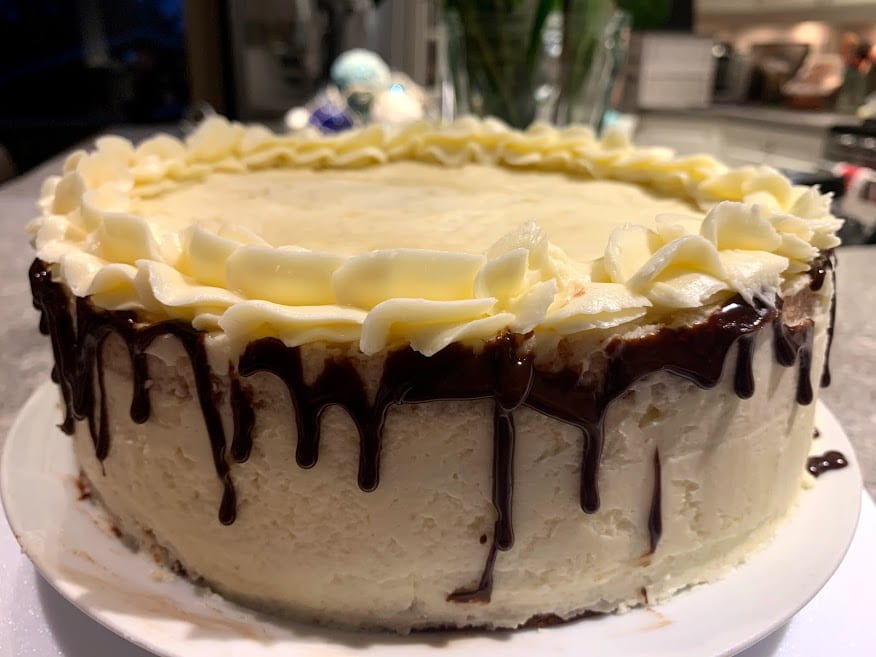Progress report:
These past two weeks, I met twice with my mentor Cassandra, and I have finally finished my ongoing cake! The first step was to fill the cakes with the buttercream and ganache that I had made in previous weeks. First, I cut my two cakes in half, creating four layers. Around each lay, I piped a rim of buttercream, and then filled the layer with the ganache, and finally stacked the layers on top of each other.


The next step was to ice the cake. I used a metal spatula and placed large globs of the buttercream onto the outside of the cake. Then I smoothed out the buttercream with the spatula. This first layer is called the ‘crumb coat’. I chilled the cake with only the first coat of icing overnight in the fridge.
Once i took the cake out of the fridge the following day, I decorated the cake with the leftover ganache and piped a rim of buttercream around the top of the cake. This final step was the most fun; I created a huge mess, and I got to see the whole cake come together. When piping the buttercream and doing the drips around the cake with the ganache, I only had one chance to get it right, so I tried really hard to make it as perfect as possible. I’m really happy with the result, especially since it’s my first cake! And it tasted delicious!


How to have a Beautiful Mind
The next two chapter of How to Have a Beautiful Mind are “How to Listen,” and “Questions.” The first of these chapters covers topics such as finding value in conversations by listening and learning. Some of the strategies De Bono presents are repeating back what a speaker has said to clarify, summarizing by condensing and repeating back, and asking more details surrounding points that interest you. One quote that stood out to me was this: “There are few things uglier than a listener who does not want to listen and is only waiting for the moment that he or she can speak” (67). Another good quote was “Talking only rarely gives you something new” (67).
The next of the two chapters covers how to ask the best questions and why we ask them. This chapter discusses the uses of both fishing and shooting questions, as well as multiple choice questions and asking more modifications. One quote that explains nicely why we ask questions is this: “We use questions to get someone to direct his or her attention to something we want or want to know” (78).
What new information am I getting and what questions did I ask to probe further into the topic?
During these past two weeks, I have gotten a lot of new information from my mentor as I filled and decorated my cake. One example of when I received information that I probed further into was when learning how to pipe the rim of buttercream around the edge of the cake. Cassandra, my mentor, was explaining how to pipe little “shells” on the cake, and I asked several questions to clarify and confirm that I was executing the skill correctly. Before even beginning to pipe, I had to fill the piping bag with buttercream, choose a piping tip, and cut a hole in the piping bag for the piping tip to fit in. One example of a questions I asked to confirm that I was completing each of these steps correctly was this:
“Is there a certain amount I should cut off the tip of the piping bag?”
I also asked questions such as “How should I hold the piping bag?” and “Which piping tips should I use for this skill?”
All of these probing questions helped me decorate the cake as perfectly as possible.

Discuss any new points of view I developed while in conversation with my mentor.
While I was decorating the cakes, I made quite a mess, because the liquid ganache was getting everywhere, and I had so many dirty dishes. As I went, I was washing my dishes so that I could clear space and feel a bit tidier.
“I usually just put them in the dishwasher while baking, and if they can’t go in the dishwasher, I just wash them before continuing baking,” I explained during our meeting.
Cassandra, on the other hand, mentioned that she neatly puts all her dishes to the side while baking, and then cleans them all at once at the end. To me, this showed how well-organized Cassandra must be to keep her station clean and still only need to wash dishes at the end. This was a new point of view I developed, and I will now strive to keep my kitchen more organized while I bake so that I do not have to be constantly doing dishes and cleaning up.

What were some of the alternative perceptions that are new to me?
As I discussed in the previous header, one of the alternate perceptions I gained while meeting with my mentor was keeping my station neat and tidy while baking. This was a challenge for me because I am used to making a mess and then just cleaning up as I go. This strategy, however, wastes a lot of time cleaning up when I could be baking. So now, I put extra effort into keeping my kitchen clean as I work, so that I complete the task faster and more efficiently.
How do my mentor’s values differ from my own?
While baking and meeting with Cassandra, I have learned that she values a very clean and organized kitchen when she works. She always has everything neatly placed and teaches me lots of strategies to keep more organized. So far, I have had to be more worried about the skills that being organized, and while I know keeping my station clean is important, I am usually alright if it’s a bit messy. On this point, Cassandra and I have differing values; she values a clean kitchen, while I am not so organized when I bake. I am going to continue to work on being more organized during out meetings so that I can learn to adopt that same value.
What questions did I ask to check on facts and details? Elaborate.
In previous posts, I have mentioned how my buttercream was a bit grainy from when I did not allow the butter to fully soften before whipping it. In our meeting before I started to fill the cakes, I asked Cassandra how I could possible fix this.
She replied, “Put the buttercream in the microwave for a minute, then whip it with a hand mixer on high. Also, if it’s still separating, you can add a bit more butter.”
“Why is it that that works? Putting it in the microwave, I mean,” I asked to follow up.
She answered, “It will rewarm the butter, and it should hopefully work.”
Through this exchange, I gained new knowledge, and in the end the buttercream looked perfect! As well, if I encounter the same problem in the future, I will know how to deal with it properly because of the information I now know.

Ask questions. Record them. Why did I ask these questions?
During our meetings, I ask several questions, whether it’s to clarify a skill or to ask what to do next. The following are several of the questions I asked:
“So, my buttercream is a bit grainy. I think it’s probably because the butter was not softened enough before I whipped it. Is there anything I can do, or someway I can fix it?” As I discussed in the previous header, my buttercream was not the right consistency. So, I asked Cassandra what I could do to fix this. Because I asked this question, I was able to fix the buttercream, and it turned out really fluffy and delicious!
“How long should I whip the buttercream for it to reach the proper consistency?” After asking how I could fix the buttercream, I asked a clarifying question about how long I should whip it for. Her answer helped me confirm that I was doing everything correctly.
“There’s one little part in the side of the cake that has a bit of a bump where there’s an indent in the icing. Can I just fill that with the buttercream?”
Her reply: “Yes you can, absolutely.”
After I had filled the cakes and had covered it in its first layer of buttercream, I had to chill the cake in the fridge for a day. When I took it out, I realized that on one side of the cake had bumped into something in the fridge, and there was a bit of a hole in the outside of the cake. By asking this question, I was able to fill the whole with leftover buttercream, and after some work, I couldn’t even tell that there had ever been an indent!
When learning how to pipe the border around the cake with buttercream, a had to go through a step by step process to successfully decorate the cake. I asked several questions during this process, and the following is one of them: “So, for the buttercream, which do I do first: cut off the end of the piping bag, or place the piping tip in the bag?”
“Place the piping tip in the bag first so that we can measure where to cut the piping bag,” was her response.
I than asked, “Is there a certain amount I should cut off the tip of the piping bag?”
Cassandra explained, “You can measure where the piping tip opening ends, and then you can cut the piping bag there, so that about half of the tip will be able to come out of the bag.”
Because I asked all these questions, I was able to complete this part of the process with precision that I would not have had if I had not asked these clarifying questions.
“With the piping bag with the liquid ganache, how do I make it not spew everywhere?” When I put the ganache into a piping bag so that I could put the drips around the cake, the ganache was, of course, a liquid. So, when I cut a hole in the piping bag, the ganache immediately began to spew everywhere. I asked this question to see how I could make less of a mess. Cassandra’s answer was this:
“I’d just place the piping bag in a Tupperware for now.”
Ask for an explanation for a certain skill I are learning. Discuss what happened.
After I had filled the cakes, I had to them ice them with the buttercream. Cassandra explained that we would put two layer of buttercream on the cake: a ‘crumb coat’ and a final coat. I asked why we used two layers instead of just one thicker layer. Cassandra explained that the first layer was just to keep the cake crumbs out of the final layer of icing. Once you put the first layer of buttercream on, you can chill it in the fridge overnight, and then when you put on the second coat, none of the crumbs will get into the outer layer since they are all trapped in the ‘crumb coat.’ This leads to a more prettier looking finished cake.

Ask a multiple-choice question. Was this useful? Explain.

When I was beginning to pipe the buttercream around the edge of the cake, I asked a multiple-choice question to help me understand the process. I asked, “So, for the buttercream, which do I do first: cut off the end of the piping bag, or place the piping tip in the bag?”
This question was very helpful as it helped narrow down the options, so the answer was quick, and I could continue what I was doing without much delay.
Ask the speaker to clarify her underlying values for doing, thinking and feeling the way they do.
When talking with Cassandra during our meeting, I found that she was constantly busy. During the meeting when I was decorating the cake, I asked her what she was doing this week. She replied, “I have a lot going on this week apparently. I have a photo shoot, which is a big cake and a bunch of little desserts that I have to make look really nice, and then I have massive cake for a birthday I’m working on.”
By asking this question, I was able to understand just how busy Cassandra is, between running her own baking business and everything else she has to do, including out mentoring meetings. This made me even more appreciative that she spends the time every week to teach me cake decorating.

Thanks again to Cassandra for helping me so much! And thank YOU for reading my post! Please feel free to comment any questions you have!